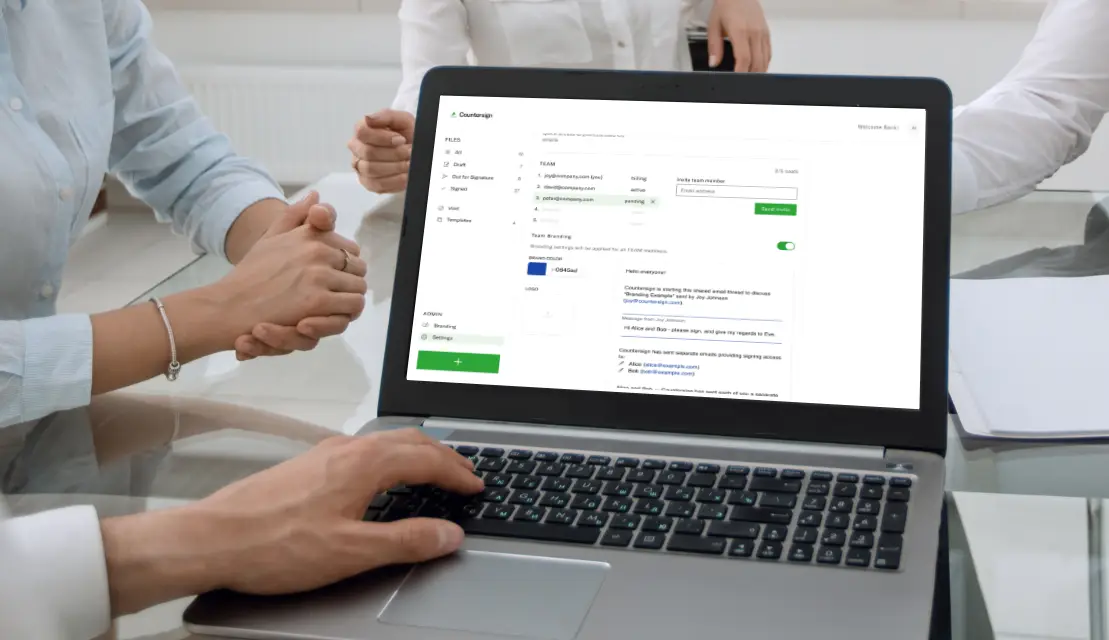Thanks to the growing popularity of remote work, business transactions, and digital documents, the need for e-signatures has become more widespread. While most people will never need to worry about e-signatures, it’s good to know what they are and how they work. Here you’ll find the most common questions and answer about important digital contracts.
Are e-signatures legally binding?
Yes, e-signatures are legally binding. The Electronic Signatures in Global and National Commerce Act (E-SIGN) was passed in the U.S. in 2000 to protect any electronic signature lawfully defined as a signature, including digital signatures and biometric signatures (fingerprints, etc.).
However, the law only protects and authorizes a handful of document types. These do not include the authorization of wills, health insurance claims, tax returns, business records, or other personal documents not explicitly named in the Act.
Get started with e-signatures in Countersign –
for free and available in your favorite browser.
Try it now
Are e-signatures as legally binding as “wet” or paper signatures?
Yes, e-signatures are as legally binding within the United States as handwritten signatures on paper. That said, you must be careful about which software or platform provides you with e-signature facilities — the wrong software could affect the integrity of your documents and the legality of your signatures.
Furthermore, the American Bar Association states that the digital trail of properly authenticated e-signatures can be even more secure than physical signatures since the digital version is fully traceable and cannot be altered. Ensure your e-signature software is fully compliant with all these recommendations before using it for legal documents like contracts or agreements.
The right online e-signature solution should be traceable and easily authenticated by any authority who needs to. This involves creating a digital trail and converting them into digital signatures. This way, you can use the unique keys provided by the software to ensure proper encryption.
Are e-signatures and digital signatures the same thing?
Yes and no. E-signatures and digital signatures are essentially the same as they both refer to the process of transferring a signature onto an electronic document.
The main difference is that digital signatures add an extra layer of security with encryption. Unfortunately, they’re unable to capture the intent of the signature bearer, so you may want to use it in conjunction with an e-signature to make the document more verifiable.
Are e-signatures difficult to trace?
No, e-signature tracking software makes it very easy to trace an e-signature. If a document is encrypted with a digital signature, you will see the “chain” of files through which it was passed. This can help you reconstruct the chain of custody and help identify alterations along the way.
In addition, once you recover the file, you can check to see if it has been tampered with since it was signed by taking advantage of hashing algorithms.
And unlike “wet” signatures, you can significantly reduce the risk of forgery by using secure e-signature software.
Do e-signatures on complex financial agreements remove human interaction?
E-signatures are only as secure as the data used to sign. If the document you sign is not fully compliant, then the accuracy and integrity of your e-signature will be in question. So no, there is no way around human interaction in regards to digital signatures.
Some e-signature services even allow you to create an electronic signature with different requirements than the one you’re signing. This is often for legal reasons or to validate that you have agreed with the terms of the document in question, and it will not affect how your e-signature is interpreted.
When dealing with e-signatures, you’ll still need to interact with a human to assist you. Some banks and financial institutions offer this service. Thus, ensure that you have assistance every step of the way and that you have a point of contact if you need some clarifications before and after you sign your digital documents.
Conclusion
E-signatures are an efficient and easy way to sign documents — they are secure and legal, as long as you use them properly. And since they’re digitally signed with a unique key, it’s easy to confirm that your signature is authentic.
Make sure that you have a trustworthy e-signature software provider and that the trail of all your documents is protected and verifiable. This will help the security process and help you avoid potential legal problems down the road.
Give Countersign a try on us.
First 5 docs are free. Get 3 more docs free monthly.
Get started





